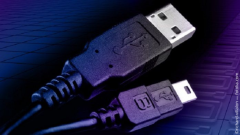USB

Different USB Types
- USB 1.0: This Universal Serial Bus (USB) standard offers a fast master/slave interface in star topology with a maximum of 127 devices. Each cable section is 5 metres (with up to 6 hubs, max. 30m distance). Low-speed 1.5 Mbit/s and full-speed 12 Mbit/s, 5V 500mA of power (limited to 100mA during startup) are possible.
- USB 2.0: The 2.0 specification is the addition of a high-speed 480 Mbit/s data transfer mode.
- USB 3.0: The 3.0 standard is backward compatible with USB 2.0, but can deliver more power (900mA). In also adds a super-speed >4.8 Gbit/s data transfer rate.
- Wireless USB: This specification is a short-range, high-speed radio communication protocol (480 Mbit/s up to 3 m and 110 Mbit/s up to 10 m).
USB 1.0 and USB 2.0 use a cable with 4 wires (Vbus, Gnd, D+ and D-). USB 3.0 requires 8 wires (Vbus, Gnd, D+ and D-, SSrx- + SSrx+, SStx- + SStx+). To detect and accelerate a device, the device applies 3V (1.5KOhm pulse-up resistance) to the D wire (low speed) or to the D+wire (full speed/high speed require more information/handshake on the D+ wire).


